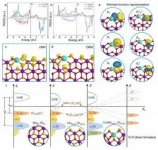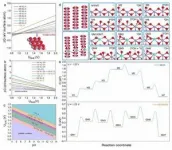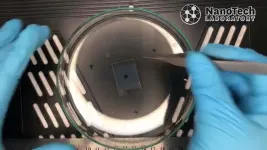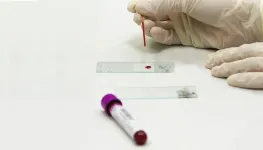(Press-News.org) The National Science Foundation has announced a $22 million grant to establish a “BioFoundry” laboratory for the study of extreme microorganisms with collaborating facilities at UC Riverside, UC Santa Barbara, and Cal Poly Pomona.
The BioFoundry for Extreme and Exceptional Fungi, Archaea, and Bacteria, or ExFAB, will focus on developing techniques to learn from nature’s more unusual microorganisms. These microbes are considered “extreme” because they have unusual nutritional requirements, grow at extremely high or low temperatures, or grow without oxygen—traits that make them difficult to study with existing laboratory equipment.
Researchers at the three institutions hope to harness their outlier characteristics for applications ranging from the biosynthesis of fuels and other products to the bioremediation of polluted water and soil. The ExFAB laboratory also will advance scientific knowledge about the “rules of life” by revealing how these organisms can thrive in some of Earth’s most extreme environments.
“ExFAB provides an exciting opportunity to open synthetic biology to the vast diversity of microbes that nature provides,” said ExFAB co-director Ian Wheeldon, a chemical and environmental engineering professor in UCR’s Marlan and Rosemary Bourns College of Engineering and an expert in synthetic biology and engineering non-conventional microbes.
“The current focus of synthetic biology has been to develop new approaches to engineering a small number of commonly used microbes,” Wheeldon said. “This facility will dramatically broaden this approach by enabling synthetic biology in any microbe.”
The UCR facility is expected to begin operations early next year. It will be in Bourns Hall on UCR’s main campus, cover about 1,500 square feet, and have four employees, Wheeldon said.
Research bottlenecks at the new facility will be eliminated using automated liquid handlers, novel robotic workflows, technology powered by machine learning, and first-of-its-kind instrumentation, Wheeldon said. For example, a researcher who needs to know how a hundred microbial species grow in 10 different environmental conditions would no longer have to do 1,000 different painstaking experiments because of the automated processes in the ExFAB.
In just one example, laboratory is expected to advance research by UCR associate professor Yujie Men, who has identified bacteria species that can destroy certain “forever chemical” water pollutants, which have stubbornly strong carbon-to-fluorine bonds that allow them to persist for decades in the environment. Such bacteria are needed for the economical clean-ups of polluted groundwater resources used by drinking water providers throughout the nation.
“This leading-edge intersection of technology and the life sciences is tremendously important,” said Christoper S. Lynch, dean of the Bourns College of Engineering. “It opens new opportunities for discoveries and breakthroughs and provides new facilities for sophisticated experimental work. This collaboration with UC Santa Barbara and Cal Poly Pomona will help each of our respective university systems to share resources, expand our research footprints, and strengthen the impacts of our breakthroughs and innovations.”
ExFAB will also establish educational programs to attract and train the future biotechnology workforce from the UC and Cal State systems, including a 10-week research internship program for Cal State master’s students at UCSB or UCR. ExFAB will also offer summer training for researcher who will use the laboratory.
“We are extremely excited because this funding enables us to build infrastructure that nobody, especially in academia, has had access to before,” said Michelle O’Malley, a professor of chemical engineering and bioengineering at UCSB and an ExFAB co-director.”
END
NSF grants $22 million for 'extreme microbe' lab collaboration
Pollution cleanup is just one of many applications
2024-08-29
ELSE PRESS RELEASES FROM THIS DATE:
UC Santa Barbara to lead $22M NSF-funded center on exceptional microbes
2024-08-29
(Santa Barbara, Calif.) — This week, the National Science Foundation announced the award of a six-year, $22M grant to UC Santa Barbara under its biofoundries program for the establishment of the BioFoundry for Extreme and Exceptional Fungi, Archaea and Bacteria (ExFAB), a collaboration led by UC Santa Barbara (UCSB), together with UC Riverside (UCR), and Cal Poly Pomona (CPP). ExFAB establishes the nation’s first biofoundry that focuses on largely untapped and unexplored extreme microbes. UCSB's award is one of only five grants made under NSF's BioFoundry program during this funding cycle, which awarded ...
Misconceptions about dyslexia among professionals risk children being misdiagnosed
2024-08-29
Misconceptions about dyslexia are held by professionals who assess children for the learning difficulty, according to a new study which calls for evidence-based standardised assessment procedures.
The research, led by Durham University, found that almost half of dyslexia professionals in the study believed at least one unproven indicator for dyslexia, which could lead to children being misdiagnosed.
In a survey of 275 dyslexia professionals, the most common myth – which is not backed up by solid evidence – was that people with dyslexia read letters in reverse order, believed by 61 per cent of specialists.
Just over 30 per cent of professionals also ...
Breakthrough in semiconductor patterning: New block copolymer achieves 7.6 nm line width
2024-08-29
A recently developed block copolymer could help push the limits of integration and miniaturization in semiconductor manufacturing, report scientists in Tokyo Tech and TOK. Chemically tailored for reliable directed self-assembly, the proposed compound can arrange itself into perpendicular lamellar structures whose half-pitch width is less than 10 nanometers, outperforming conventional and widely used block copolymers.
Miniaturization is one of the fundamental qualities of modern electronics and is largely responsible for the incredible increments in performance witnessed ...
Fission chips – How vinegar could revolutionize sensor processing
2024-08-29
Researchers at Macquarie University have developed a new way to produce ultraviolet (UV) light sensors, which could lead to more efficient and flexible wearable devices.
The study, published in the journal Small in July, shows how acetic acid vapour – essentially vinegar fumes – can rapidly improve the performance of zinc oxide nanoparticle-based sensors without using high-temperatures for processing.
Co-author Professor Shujuan Huang, from the School of Engineering at Macquarie University, says: “We found by briefly exposing the sensor to vinegar vapour, adjoining ...
Certain diabetes drugs might prevent dementia
2024-08-29
Sodium-glucose cotransporter-2 (SGLT-2) inhibitors used to treat type 2 diabetes might prevent dementia, providing greater benefits with longer treatment, suggests a large study from Korea published by The BMJ today.
As this study was observational, the researchers note that the effect size could have been overestimated and say randomised controlled trials are now needed to confirm these findings.
According to the World Health Organization, the number of people with dementia globally is expected to reach 78 million ...
Lower HPV vaccination coverage among girls with mental health conditions
2024-08-29
Girls with mental illness or neurodevelopmental conditions are less likely than their peers to be vaccinated with the HPV vaccine that protects against future cervical cancer. This is according to a new registry study from Karolinska Institutet in Sweden published in The Lancet Public Health.
The study involved more than 115,000 girls covered by the Swedish school-based human papillomavirus (HPV) vaccination programme. The vaccine, which prevents cervical cancer, among other things, is offered to all children in Sweden and given by school health services.
Significant ...
Scientists discover how the body's killer cells attack cancer
2024-08-29
Scientists are on the verge of a cancer breakthrough after working out how the body’s immune system targets cells devastated by the disease.
A new study has discovered that our natural killer cells, from the immune system which protect against disease and infections, instinctively recognise and attack a protein that drives cancer growth.
The experts say that by hijacking this protein, known as XPO1, they may be able to activate more killer cells to destroy the disease.
Scientists from the University of Southampton, working with experts worldwide, led the study and now believe it could offer new ...
Interprofessional training in health sciences education has a lasting impact on practice
2024-08-29
Geriatrics experts have long known that collaboration is key to delivering quality, patient-centered care to older adults.
That’s why USC’s Interprofessional Education and Collaboration for Geriatrics (IECG) trains up to 150 students annually from seven health professions to teach the importance of teamwork in meeting the complex needs of the elderly.
Now, a study published in the Journal of Interprofessional Care highlights the long-term impact of IECG on USC health sciences graduates.
Researchers surveyed graduates one to three years after completing IECG to assess how the program influenced their practice. The findings were significant: 81% ...
Study reveals molecular mechanism behind MS and other autoimmune diseases
2024-08-28
New Haven, Conn. — More than two decades ago, a research team in the lab of David Hafler, a Yale researcher who at the time was at Harvard, discovered a type of T cell in humans that suppresses the immune system; they later found that these so-called regulatory T cells, when defective, are an underlying cause of autoimmune disease, specifically multiple sclerosis (MS). For many years, however, the mechanism behind this dysfunction has remained unclear.
In a new Yale-led study, a team of researchers finds that this loss of immune regulation is triggered by an increase in PRDM1-S, a protein involved in immune function, ...
To build a thriving electric vehicle market, prioritize equity and justice
2024-08-28
When it comes to purchasing and using electric vehicles (EVs), housing- and income-related factors significantly shape perceptions and preferences among potential buyers, finds a new study in Energy and Climate Change. This research, a collaboration between the Boston University Institute for Global Sustainability (IGS) and the U.S. Department of Energy’s National Renewable Energy Laboratory (NREL), is among the first to examine both EV adoption and charging infrastructure through an equity lens coupled with state-of-the-art original survey data.
Understanding the barriers to widespread EV adoption ...
LAST 30 PRESS RELEASES:
Why nail-biting, procrastination and other self-sabotaging behaviors are rooted in survival instincts
Regional variations in mechanical properties of porcine leptomeninges
Artificial empathy in therapy and healthcare: advancements in interpersonal interaction technologies
Why some brains switch gears more efficiently than others
UVA’s Jundong Li wins ICDM’S 2025 Tao Li Award for data mining, machine learning
UVA’s low-power, high-performance computer power player Mircea Stan earns National Academy of Inventors fellowship
Not playing by the rules: USU researcher explores filamentous algae dynamics in rivers
Do our body clocks influence our risk of dementia?
Anthropologists offer new evidence of bipedalism in long-debated fossil discovery
Safer receipt paper from wood
Dosage-sensitive genes suggest no whole-genome duplications in ancestral angiosperm
First ancient human herpesvirus genomes document their deep history with humans
Why Some Bacteria Survive Antibiotics and How to Stop Them - New study reveals that bacteria can survive antibiotic treatment through two fundamentally different “shutdown modes”
UCLA study links scar healing to dangerous placenta condition
CHANGE-seq-BE finds off-target changes in the genome from base editors
The Journal of Nuclear Medicine Ahead-of-Print Tip Sheet: January 2, 2026
Delayed or absent first dose of measles, mumps, and rubella vaccination
Trends in US preterm birth rates by household income and race and ethnicity
Study identifies potential biomarker linked to progression and brain inflammation in multiple sclerosis
Many mothers in Norway do not show up for postnatal check-ups
Researchers want to find out why quick clay is so unstable
Superradiant spins show teamwork at the quantum scale
Cleveland Clinic Research links tumor bacteria to immunotherapy resistance in head and neck cancer
First Editorial of 2026: Resisting AI slop
Joint ground- and space-based observations reveal Saturn-mass rogue planet
Inheritable genetic variant offers protection against blood cancer risk and progression
Pigs settled Pacific islands alongside early human voyagers
A Coral reef’s daily pulse reshapes microbes in surrounding waters
EAST Tokamak experiments exceed plasma density limit, offering new approach to fusion ignition
Groundbreaking discovery reveals Africa’s oldest cremation pyre and complex ritual practices
[Press-News.org] NSF grants $22 million for 'extreme microbe' lab collaborationPollution cleanup is just one of many applications





